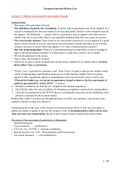European Internal Market Law
Lecture 2 - Market access and free movement of goods
General issues
- The scope of the provision of goods
- The definition of good & free circulation: It can be sold an purchased, may nıt be tangible. It is
crucial to distinguish the free movement of services and goods. Goods in some situations may be
the support. The billboards —> poster itself is a good but is only in support with other activity
which is the service provided. Such a case should be handled under free movement of services.
- The cross border element: There needs to be cross-border element for it to be applied. If a good
doesn’t cross a border. If you are sure that its free movement of goods and there is cross-border
element, you have to check which rule applies. Is it treaty ot harmonization measure?
- The role of harmonization: If there is a total harmonization on that field, you have to judge in
light of the harmonization measure. If it harmonizes a small part, you have to be careful.
- MS are the addresses of the treaty.
- Direct effect: Horizontal or Vertical?
- Article 34, to who it can be invoked? The answer shows whether H or V Direct effect. Vertical
direct effect: You vs. provisions.
- “Frabo” case: A question fro domestic court: Does Article 34 apply to private law entities which
certify certain products and therefore grants access to the German market? Free movement
applies to MS, competition applies to undertakings or private law bodies starts to shift away.
“Private-law bodies are, in certain circumstances, bound to observe the free movement of
goods as guaranteed by Article 28 EC.” 3 reasons:
1. Products certified by the DVGW are compliant with national legislation.
2. The DVGW offers the only possibility for obtaining a compliance certificate for such products.
3. The lack of certification by the DVGW places a considerable restriction on the marketing of the
products concerned on the German market.
Bottom line is that if you don’t go through that body to certify your products, your access to the
market is limited or made less attractive.
Interesting point of this case is that it points to horizontal direct effect. It does not only apply to
public law bodies it applies to private law bodies as well. So horizontal direct effect can be seen.
That why this case is interesting. But the Court of justice doesn’t mention this direct effect.
Provision of free movement of goods have 2 dimensions
- Internal dimension
- Fiscal measures —> tariff barriers
• CD, CEE (Art. 30 TFEU) - Absolute prohibition
• Internal taxation (Art. 110) - Discrimination and Protectionism
- Non-fiscal measures —> non-tariff barriers
, European Internal Market Law
Questions to ask concerning free movement of goods:
- Is there a good?
- Is there a cross-border element?
- Is there harmonization in the field, if there is, we focus on the harmonized measure. If there is
none, we move to the treaty provisions.
- Treaty provisions:
• Fiscal measures - tariff barriers > money has to change hands before entering the market
A. Custom duties (CD), charges having equivalent effect (CEE) > these infringe Article 30 of
the treaty. You apply Article 30 when a good crosses a border.
B. Internal taxation > infringe Article 110, (they cannot be applied at the same time, they are
mutually exclusive). You apply this article when the good is already in the country and already
ready to be marketed.
Art. 34 & 35 TFEU: QR & MEE on Imports & Expo: Quantitative restrictions. These are
hardcore restrictions on trade.
• Non-fiscal measures - non- tariff barriers > no one has to change in entering but there is another
obstacle. If you cannot overcome the obstacle by paying
A. Quantitative restrictions (QR), R: Total / Partial restraint of import / export / transit: If I’m
telling you that you cannot import a certain product in a country, that is a total ban. Or
you can import this many products per month that is a quota as well. Product up to a
certain value, its a quota. It is contrary to the original idea of this freedom. Article 34 says
quantitate restrictions are prohibited.
Quantitative restrictions can only be justified on limited grounds. Consequently they can be
justified by the grounds indicated in Article 36. Only 6 grounds that can be invoked. You have to
identify a goal to protect. Public policy & security etc. the next step is to make sure that the limit is
proportionate.
B. Measures having equivalent effect (MEE)
- Types of MEEs: There is no definition in the treaty. So case law.
Dassonville case
It gives us the definition the MEE. It entails; all trading rules that are enacted by the MS that
directly or indirectly, actually or potentially hinder intra-union trade should be regarded as MEE. A
very broad definition. Article 34 dealing with MEE has vertical direct effect. So it can be invoked
in front of the MS. If your MS prohibits something you can sue your MS. And according to Frabo
you can sue private law standardization bodies.
> de minimis?
What if there is a very small hinder effect? Is it still MEE? When it comes to charges having
equivalent effect, there is no de minimis approach. Everything related to free movement law,
there is not a de minimis approach.
> article 35, Groenveld case- MEE on exports
, European Internal Market Law
Tests to be used:
1- Dassonville test: It gives us the definition what are MEE.
2- Groenveld test: MEE for Article 35
3- Kranz test: “Remoteness test” If a particular national measure has very little connection with
internal market law, then it is probably not coop with article 34. It’s probably not a MEE.
4- Discrimination test
The idea European Integration was concerned with the principle of discrimination. (National
measures should not discriminate against imported goods, or incoming workers, capitals etc.)
Distinctly/indistinctly applicable measures. Discrimination can take place in two different forms.
Direct discrimination and indirect discrimination.
A. Direct discrimination means that the law itself treats the national and imported goods
differently.
Additional requirements on imported / exported goods
- Rules limiting channels of distribution
- Rules giving preference to domestic goods (Buy Irish, Irish Souvenirs) You need to have a product
comparable to the imported one.
> Buy Local / Origin Marking Rule
Both directly and indirectly discriminatory measures breach Article 34. The only difference is how
you justify them.
The original idea is that only Article 36 can be used to justify. There are only originally 6 grounds
(exhaustive) but EU law is changing. Environmental issues are becoming more and more important.
There are measures which is in benefit of the environment yet discriminates directly.
For ex: Alands Vindkrat case The Court of justice didn’t use the term discrimination in its
judgement. It says that the measure hinders the trade. In that way, by not using this term
“discrimination” you can justify beyond the ones stated in Article 36 only.
5- Mutual recognition test (concerning indirect discrimination). It says if you legally produce in one
MS, you actually have access to all the other MS as well. Unless the MS invokes a rule of reason in
order to protect a particular interest.
B. Indirect ones, the law treats the the same way but in practice, the imported has a heavier burden.
- Form, Size, Composition, Labelling → Product Requirements
- Cassis de Dijon
: Mutual Recognition and Mandatory Requirements / It says if you legally produce in one MS,
you actually have access to all the other MS as well.
- Which form of control? The France controls in this case, the standards of the liquor. However, by
allowing the host country, by invoking a certain interest, the rule of reason, the home state control is
, European Internal Market Law
moderated. The host state has still something to say but only if they manage to invoke that
public interest in a proportionate manner.
They can be justifies by Article 36 or the rule of reason + proportionality.
Because the tests were too broad, lots of cases.
Market circumstances rules
- Its a limitation of distribution channels that you have.
- Are they considered as MEE, do they fall into Article 34?:
- this was the case “Keck” where the CJ had to rule whether the modality of selling a product is a
measure having equivalent effect or not? They are selling products at loss.
1. Those rules which tell you where, how and when to sell a product they are called MC rules,
they do not have the object to protect the domestic market. They do not want to prevent access.
2. Most of the times they are non discriminatory. If I tell you you are allowed to sell alcohol in
liquor stores not in markets, it doesn’t matter where the alcohol comes form; domestic or
imported.
3. Such rules place the regulatory burden on the retailer not on the importer or the exporter. The
difference is, when we were talking about MEE, it wasn’t about the production, its about
importing, exporting, marketing. It’s not about when or where the retail can sell product.
With Keck judgement the CJ wanted to make a distinction because they were floated with case law.
Between those rules who actually related to the product, called product requirements already
established in Cassis (indirect discrimination) and selling arrangements.
The first ones are about the goods; size, form, composition (everything that was discussed in Cassis
de dijon) they breach article 34. Whereas selling arrangements are taken out of the scope of Article
34.
Only two criteria: In Keck ruling: They apply to all the traders (principle of universality) and
they do not discriminate in law or in fact domestic goods and imported goods (principle of
neutrality) that domestic law will not be considered as a MEE. All of a sudden the definition of
Dassonville case has been shrunk down. Selling arrangements have become exceptions.
If there is a prohibition on opening your shop on Sunday, there is a selling arrangement because et
concerns when you should sell your goods. If it impacts the same way domestic and imported and if
it affects everyone around that territory, then it is not a problem. It’s a selling arrange that meets
this criteria.
Selling arrangement do not prevent access to market, so we have a new test. The consequence of
selling arrangements not being MEE is that they do not prevent access to the market. They cannot
be justified using article 34. It is the MS has to justify the MEE. Burden of proof differ.






